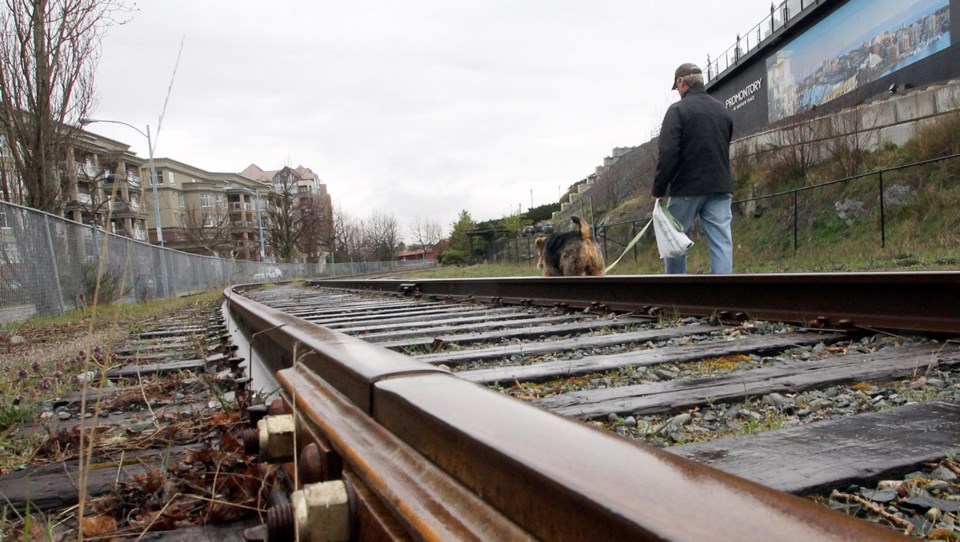The Island Corridor Foundation remains optimistic that rail service will be restored to Vancouver Island despite endless studies and “analysis paralysis” within the provincial government, says the foundation’s CEO.
In a presentation to Esquimalt council, Larry Stevenson said the province’s ongoing assessment of the E&N rail corridor and the costs associated with bringing it up to current standards shows more promise than he initially thought.
“I was very vocal at the time when they came out with this as it being just another study,” he said. “But I have to say I’m cautiously optimistic.
“In fact, I was pleasantly surprised when they brought the team out that is doing the assessment. These are railroad people. These are people that have worked for CP [Canadian Pacific] for 40 years. They’re people that know track. They know how to rebuild track.”
Stevenson said one “point of caution” is that the foundation has had minimal input in the study. The non-profit foundation owns the rail line that runs north from Victoria to Courtenay and west to Port Alberni. Passenger service ceased in 2011 amid safety concerns about the track. “The scary part is that at the beginning of this, they told us that they were doing this to determine if rail is even required,” he said. “We’re hopeful that we’re not just simply kicking the can down the road.”
The Ministry of Transportation and Infrastructure said in a statement Tuesday that it expects to have the results of its engineering assessment of the corridor by the end of the year.
“The province has committed to an ‘all-in’ assessment to determine the costs associated with restoring rail service on Vancouver Island,” the statement said. “This work will include looking at the entire corridor, including the line to Port Alberni. This also includes the cost of imperative safety work, a seismic risk assessment and complete rock-fall review to ensure any potential passenger rail service meets current day safety standards.
“This assessment is necessary before any decisions are made around investing significant public dollars along the Island Rail Corridor.”
In February, the capital region’s 13 mayors urged immediate action to get passenger trains running on the E&N Rail line from Langford to Victoria as a first step toward restoring service across the Island.
In open letters to Premier John Horgan, the mayors noted that there was overwhelming support for rail at an E&N stakeholder meeting in December 2018.
Esquimalt Mayor Barb Desjardins, a CRD representative on the Island Corridor Foundation’s board, said in an interview Tuesday that she shares Stevenson’s cautious optimism about the track’s future.
“He’s a railway guy,” she said. “He knows the business. I’m just hopeful that the province will take some time to really understand it.
“With climate emergencies being declared everywhere, it is a better mode of transit if we can get it up and going.”
Stevenson told Esquimalt council that there have been no fewer than 12 studies of the corridor over the years. “I’ve got tell you, I’ve been in the railroad business for 25 years; I’m absolutely convinced this is the most studied piece of track in North America, bar none,” he said.
Multiple studies, however, have created more confusion than clarity, he said. “Part of the reason for that, in my view, is there’s a real lack of expertise and understanding within the [transportation] ministry here in B.C.
“They, to some extent, struggle with analysis paralysis. They build roads. … They’re really good at roads, but rail is pretty complicated in their view, because they don’t build rail. So for them, this is a whole different animal.
“And I’m not taking a shot at them, as much as I’m saying that we don’t have the expertise in-house within the ministry to actually look at rail for what it is.”
Stevenson said the 290-kilometre corridor should be seen as an “amazing” asset for the Island.
“There’s countries and cities and municipalities that would cut their arms off for that,” he said. “On our books, it sits there at $380 million in value. I would suggest to you it’s a lot more than that. You’re probably in the billions of dollars, because you just can’t find a contiguous piece of property like that.”
Stevenson said Island residents and governments can’t afford to squander that and should be looking at the corridor as a way to deal with population increases and the impact of climate change.
“We get caught up in what is it going to be tomorrow,” he said. “But what we really need to be worried about is what’s this going to look like 30 years from today, because if we have issues today, we have huge issues 30 years from now. When you can run a train that has one-third the carbon footprint of a bus, I would suggest we might want to think about running a few more trains.”



